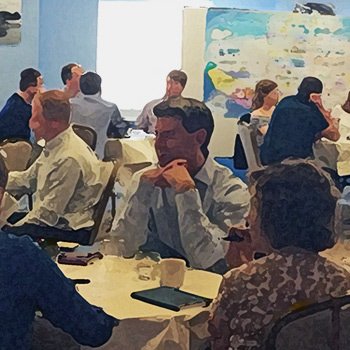These days I think it is generally acknowledged that collaborative planning is more effective than a leader locking herself in a room with a towel on her head and figuring out all the answers. However, there is more to collaborative planning than just getting a group of people together in a room, and hoping the magic of multiple perspectives will take place. Having spent 17 years facilitating group planning, here are some of my thoughts and ideas for those heading into the year end planning cycle.
Who and how to involve
It might sound obvious but getting the right people involved and being intentional about how we want to collaborate is key. Collaborative working doesn’t necessarily mean consensual decision making with everyone involved. Sometimes it is best to pick a small team to co-create a plan with. Sometimes we consult with a wider audience as input to planning or we can test draft plans with a wider group after a small group has done some work. Alternatively, getting a large group together to do the whole thing in one go can be hugely effective, but be mindful this requires large group facilitation expertise.
So, I find it helps to map out all the stakeholders and then look at them individually and think about how you want to engage with them. A kind of plan for how to plan!!
Hindsight
The pace that most businesses are moving at, combined with the pressure on many leaders and managers means that little time is made for reflection and learning in the workplace these days. The tendency is to do a cursory glance at the results from last year, before drawing conclusions and moving into future planning. This often leads to repeating patterns in businesses, which never get resolved.
So, I would encourage anyone doing planning to make time to really explore the facts and data of what has happened, then look at how things happened and the different experiences of that, as a source of rich learning and hindsight that can dramatically inform future plans.
Insight
Insight is the bridge between the past and the future. Profound insight is rooted in data, but in the age of BIG DATA, we need to be choiceful about which data we pay attention to and how that is converted onto information, before knowledge and then wisdom can be formed.
Insight development also benefits from using different modes of knowing. Most senior teams have a preference for the logical cognitive space, and leaders are usually highly developed in their thinking skills. But how often do we really leverage the amazing right brain capability of human beings. Our right hemisphere enables us to sense and notice patterns to bring insight that analysis of facts and figures can’t.
Foresight
Oh to have a crystal ball !
I know we are called Meeting Magic, but unfortunately my magical powers do not extend to being able to give groups ‘Mystic Meg – like’ qualities. So, instead we have to develop strategies that are rooted in foresight – this means extrapolating from insight into what might be. This work REALLY benefits from right brain work. By this I don’t mean lying on bean bags coming up with crazy ideas, I mean creating an environment in which ‘right answers’ are not the goal, a more exploratory creative way of thinking… wondering why things are the way they are now, and what that means for how things might be.
The art of great planning is to create a plan that is sufficiently grounded in reality that people can see it will work, and yet it has sufficient stretch that it creates a slight tension. The pulling together of plans which build on hindsight, anchor to insight and stretch into foresight is key.
Then we need to think about how we sense and respond throughout the forthcoming year, so that we notice if those insights change and the strategies need to change with them. This approach is the art of agile planning – planning for the unplannable – knowing and working with the fact that we live in a changing world – behaving like an organic, living system, rather than a machine.
So, I hope you find this useful thought provocation to enable you to think about howyou go about planning this year. Just remember, like any good cook, it’s not just about having the right ingredients, it’s also about how you combine them that determines whether your meal is a delight or a disaster!


